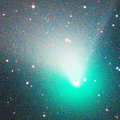
|
It approached to Earth down to 0.29 a.u. in early February, and it brightened up to 4.5 mag (Feb. 1, Juan Jose Gonzalez). Now it is fading. But it is still very bright as 6.1 mag (Feb. 9, Osamu Miyazaki). In the Northern Hemisphere, it stays observable in excellent condition for a long time. It is observable in good condition after this also in the Southern Hemisphere.
Date(TT) R.A. (2000) Decl. Delta r Elong. m1 Best Time(A, h)
Feb. 11 4 48.14 26 11.0 0.419 1.209 112 5.9 20:31 (163, 28)
Feb. 18 4 39.83 11 28.0 0.609 1.256 101 6.9 20:21 (150, 39)
|

|
Now it is very bright as 8.7 mag (Feb. 2, Chris Wyatt). It is observable at 8 mag for a long time from 2022 to 2023. In the Southern Hemisphere, it stays observable for a long time. In the Northern Hemisphere, it is not observable until summer.
Date(TT) R.A. (2000) Decl. Delta r Elong. m1 Best Time(A, h)
Feb. 11 0 17.46 -67 28.6 2.228 1.921 59 7.9 20:31 ( 28, 34)
Feb. 18 1 6.73 -64 15.9 2.229 1.954 61 7.9 20:21 ( 32, 37)
|
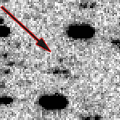
|
It approached to Sun down to 0.1 a.u. on Jan. 31. Appearing in the morning sky. Now it is bright as 7.0-7.5 mag (Feb. 5, Michael Jager). It stays observable after this while the comet will be fading.
Date(TT) R.A. (2000) Decl. Delta r Elong. m1 Best Time(A, h)
Feb. 11 20 12.47 -6 26.2 1.157 0.442 22 8.8 3:56 (283, -7)
Feb. 18 20 10.30 -6 34.1 1.297 0.636 28 10.9 4:05 (278, 0)
|
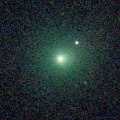
|
It brightened very rapidly. Now it is very bright as 9.9 mag (Jan. 27, Osamu Miyazaki). It stays 9-10 mag until March. In the Northern Hemisphere, it stays observable for a long time. But it locates low until spring. In the Southern Hemisphere, it is not observable until June.
Date(TT) R.A. (2000) Decl. Delta r Elong. m1 Best Time(A, h)
Feb. 11 20 54.93 56 50.0 1.775 1.738 71 9.6 3:56 (222,-41)
Feb. 18 21 36.61 54 50.8 1.864 1.735 66 9.7 4:05 (224,-42)
|
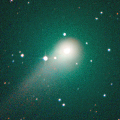
|
Now it is 10.9 mag (Feb. 9, Osamu Miyazaki). It stays bright as 10 mag for a long time until autumn. In the Northern Hemisphere, it stays observable in good condition until autumn. In the Southern Hemipshere, it stays unobservable until summer.
Date(TT) R.A. (2000) Decl. Delta r Elong. m1 Best Time(A, h)
Feb. 11 1 34.08 50 35.6 2.353 2.438 83 9.7 20:31 (144,-13)
Feb. 18 1 38.36 46 50.9 2.451 2.407 75 9.8 20:21 (139,-12)
|

|
Now it is 13.2 mag (Nov. 27, Ken-ichi Kadota). It is expected to brighten up to 10 mag from spring to summer. In the Southern Hemisphere, it stays observable in good condition for a long time, although it became unobservable temporarily from November to January. In the Northern Hemisphere, it is not observable until 2024 autumn.
Date(TT) R.A. (2000) Decl. Delta r Elong. m1 Best Time(A, h)
Feb. 11 19 11.40 -32 15.2 3.915 3.189 37 11.5 3:56 (297, 19)
Feb. 18 19 19.64 -33 37.3 3.820 3.172 43 11.4 4:05 (295, 25)
|

|
It brightened up to 8.3 mag in last winter (Jan. 6, 2022, Toshiyuki Takahashi). Now it is fading. But it is bright as 11.7 mag still now (Feb. 2, Chris Wyatt). It is observable in excellent condition in the Southern Hemisphere. It locates low in the Northern Hemisphere.
Date(TT) R.A. (2000) Decl. Delta r Elong. m1 Best Time(A, h)
Feb. 11 9 30.12 -35 1.4 4.293 4.993 130 11.7 0:09 ( 0, 90)
Feb. 18 9 24.99 -35 12.7 4.319 5.034 132 11.7 23:32 ( 0, 90)
|
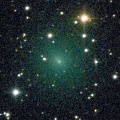
|
It brightened very rapidly up to 9.6 mag in late January (Jan. 25, Toshihiko Ikemura, Hirohisa Sato). It is still bright as 10.4 mag (Feb. 5, Katsumi Yoshimoto). It stays observable in good condition for a long time. But it will be fading after this.
Date(TT) R.A. (2000) Decl. Delta r Elong. m1 Best Time(A, h)
Feb. 11 5 15.71 36 0.9 0.617 1.390 118 11.8 20:31 (172, 19)
Feb. 18 5 35.06 26 23.6 0.683 1.423 115 12.2 20:21 (171, 29)
|
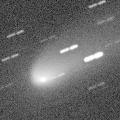
|
Now it is 11.4 mag (Jan. 27, Toshihiko Ikemura, Hirohisa Sato). It stays 11-12 mag until spring.
Date(TT) R.A. (2000) Decl. Delta r Elong. m1 Best Time(A, h)
Feb. 11 16 16.75 -18 1.6 1.635 1.696 76 11.8 3:56 (259, 47)
Feb. 18 16 32.31 -18 27.4 1.598 1.720 79 11.9 4:05 (255, 51)
|
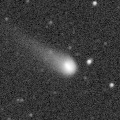
|
Now it is 12.7 mag (Feb. 2, Chris Wyatt). It stays 12 mag until summer. It stays observable in good condition for a long time.
Date(TT) R.A. (2000) Decl. Delta r Elong. m1 Best Time(A, h)
Feb. 11 13 23.78 0 38.8 3.027 3.649 122 12.1 3:56 (183, 54)
Feb. 18 13 14.13 0 15.0 2.913 3.642 131 12.0 3:25 (180, 55)
|
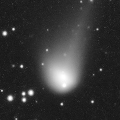
|
Now it is bright as 12.9 mag (Jan. 27, Toshihiko Ikemura, Hirohisa Sato). It stays 13 mag until spring. It stays observable in good condition for a while after this.
Date(TT) R.A. (2000) Decl. Delta r Elong. m1 Best Time(A, h)
Feb. 11 15 35.56 4 6.9 4.582 4.707 91 12.9 3:56 (227, 39)
Feb. 18 15 38.70 5 13.2 4.506 4.732 97 12.9 4:05 (217, 43)
|
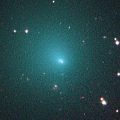
|
Now it is bright as 11.4 mag (Dec. 14, Jose Guilherme de S. Aguiar). It will be fading after this. In the Southern Hemisphere, it stays observable in good condition for a long time, although it became unobservable temporarily from December to January. In the Northern Hemisphere, it is not observable until spring when it fades down to 15 mag.
Date(TT) R.A. (2000) Decl. Delta r Elong. m1 Best Time(A, h)
Feb. 11 19 22.84 -38 47.2 2.531 1.859 38 13.1 3:56 (304, 20)
Feb. 18 19 20.22 -39 12.4 2.467 1.905 45 13.4 4:05 (301, 27)
|
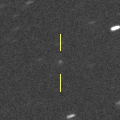
|
It brightens up to 13 mag in winter. But the condition is bad. Appearing in the morning sky in the Southern Hemisphere. It is not observable until May in the Northern Hemisphere.
Date(TT) R.A. (2000) Decl. Delta r Elong. m1 Best Time(A, h)
Feb. 11 19 53.05 -25 0.8 2.421 1.599 26 13.2 3:56 (295, 7)
Feb. 18 20 15.60 -24 19.4 2.407 1.608 28 13.1 4:05 (293, 10)
|
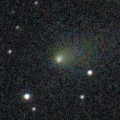
|
Now it is 13.0 mag (Jan. 21, Ken-ichi Kadota). It stays bright as 13 mag and observable in excellent condition until February.
Date(TT) R.A. (2000) Decl. Delta r Elong. m1 Best Time(A, h)
Feb. 11 8 25.73 16 2.7 0.981 1.946 162 13.4 23:01 (180, 39)
Feb. 18 8 23.67 17 16.6 1.025 1.967 155 13.5 22:31 (180, 38)
|
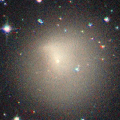
|
It brightened in major outburst in late November. Now it is bright as 11.6 mag (Jan. 18, Toshihiko Ikemura, Hirohisa Sato).
Date(TT) R.A. (2000) Decl. Delta r Elong. m1 Best Time(A, h)
Feb. 11 6 19.05 28 54.9 5.362 6.070 132 13.5 20:55 (180, 26)
Feb. 18 6 17.61 28 45.9 5.452 6.072 124 13.6 20:26 (180, 26)
|

|
Now it is 13.8 mag (Jan. 20, Ken-ichi Kadota). The brightness evolution is slower than originally predicted. It stays 14 mag until summer. In the Northern Hemisphere, it will too low to observe in late March. In the Southern Hemisphere, it stays observable in good condition for a long time.
Date(TT) R.A. (2000) Decl. Delta r Elong. m1 Best Time(A, h)
Feb. 11 3 16.22 -13 55.2 2.155 2.240 81 13.6 20:31 (110, 49)
Feb. 18 3 18.57 -14 59.0 2.222 2.207 76 13.6 20:21 (106, 46)
|
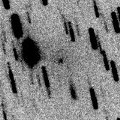
|
Tiny comet, but it approached to Sun down to 0.8 a.u. in January, and it will approach to Earth down to 0.6 a.u. in March. It will brighten up to 14 mag from January to March. In the Southern Hemisphere, it stays observable in good condition for a long time. In the Northern Hemisphere, it is not observable until early March. It has not been observed since late October.
Date(TT) R.A. (2000) Decl. Delta r Elong. m1 Best Time(A, h)
Feb. 11 0 27.87 -64 52.7 0.892 0.920 58 13.9 20:31 ( 31, 35)
Feb. 18 1 59.56 -64 29.7 0.774 0.979 66 13.9 20:21 ( 32, 43)
|

|
Now it is 15.5 mag (Feb. 6, ATLAS Chile). It will brighten very rapidly. It is expected to be observable at 11 mag in excellent condition from spring to summer. It is fainter than this ephemeris recently.
Date(TT) R.A. (2000) Decl. Delta r Elong. m1 Best Time(A, h)
Feb. 11 17 7.80 -25 31.1 2.367 2.119 63 14.3 3:56 (276, 40)
Feb. 18 17 23.69 -25 17.7 2.280 2.101 66 14.0 4:05 (273, 44)
|
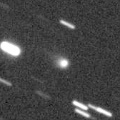
|
Now it is 14.7 mag (Jan. 11, Hiroshi Abe). It is expected to brighten up to 8 mag in July. It will be unobservable soon. In the Southern Hemisphere, it will be observable in excellent condition at the high light. In the Northern Hemisphere, it becomes very low at the high lihght.
Date(TT) R.A. (2000) Decl. Delta r Elong. m1 Best Time(A, h)
Feb. 11 0 21.60 -12 47.5 3.370 2.693 40 14.4 20:31 ( 83, 13)
Feb. 18 0 21.73 -12 29.9 3.387 2.623 33 14.3 20:21 ( 81, 9)
|
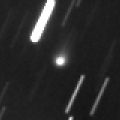
|
Now it is 15.1 mag (Jan. 29, Catalina Sky Survey). It stays 14 mag in 2023. In the Southern Hemisphere, it stays observable in good condition for a long time, although it becomes unobservable temporarily from April to May. It locates somewhat low in the Northern Hemisphere.
Date(TT) R.A. (2000) Decl. Delta r Elong. m1 Best Time(A, h)
Feb. 11 2 45.99 -13 41.3 3.509 3.386 74 14.5 20:31 (105, 42)
Feb. 18 2 41.62 -12 13.7 3.614 3.367 67 14.6 20:21 (102, 37)
|
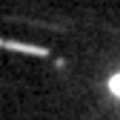
|
Now it is 15.7 mag (Feb. 4, ATLAS Chile). It will brighten rapidly up to 14 mag and will be observable in excellent condition in spring. In the Northern Hemisphere, it is observable in good condition in winter, but it becomes somewhat low in spring.
Date(TT) R.A. (2000) Decl. Delta r Elong. m1 Best Time(A, h)
Feb. 11 14 27.02 -14 50.5 1.956 2.373 102 14.8 3:56 (222, 65)
Feb. 18 14 31.12 -16 23.3 1.866 2.367 108 14.7 4:05 (206, 70)
|
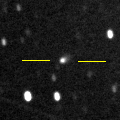
|
Now it is 14.9 mag (Feb. 6, ATLAS Chile). It is expected to brighten up to 7 mag in early 2024. In the Southern Hemisphere, it stays observable in good condition for a long time. It locates low in the Northern Hemisphere.
Date(TT) R.A. (2000) Decl. Delta r Elong. m1 Best Time(A, h)
Feb. 11 5 16.46 -36 19.2 4.406 4.690 100 14.9 20:31 ( 78, 82)
Feb. 18 5 14.47 -35 30.8 4.397 4.623 97 14.9 20:21 ( 84, 78)
|
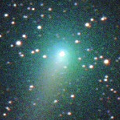
|
It brightened up to 9.3 mag in early summer (June 5, Chris Wyatt). Now it is fading. It has already faded down to 15.1 mag (Jan. 28, Ken-ichi Kadota). In the Southen Hemisphere, it stays observable in good condition for a long time. It locates somewhat low in the Northern Hemisphere.
Date(TT) R.A. (2000) Decl. Delta r Elong. m1 Best Time(A, h)
Feb. 11 7 9.49 -29 44.9 2.767 3.413 123 14.9 21:44 (180, 85)
Feb. 18 7 0.66 -26 52.8 2.862 3.477 121 15.1 21:08 (180, 82)
|
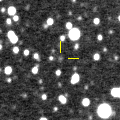
|
Now it is 15.5 mag (Jan. 24, ATLAS Chile). It will brighten up to 13 mag from 2024 to 2025. It is observable in excllent condition in the Southern Hemisphere. It locates low in the Northern Hemisphere.
Date(TT) R.A. (2000) Decl. Delta r Elong. m1 Best Time(A, h)
Feb. 11 8 56.65 -39 19.7 5.972 6.595 125 15.0 23:31 ( 0, 86)
Feb. 18 8 53.75 -39 4.2 5.927 6.563 126 15.0 23:01 ( 0, 86)
|

|
Now it is 15.6 mag (Jan. 16, Ken-ichi Kadota). The brightness evolution is slower than originally expected. It stays 14-15 mag for a long time. It stays observable in good condition for a while.
Date(TT) R.A. (2000) Decl. Delta r Elong. m1 Best Time(A, h)
Feb. 11 18 5.36 -3 38.7 3.797 3.299 53 15.0 3:56 (262, 17)
Feb. 18 18 7.43 -1 50.5 3.723 3.329 59 15.0 4:05 (255, 23)
|

|
Now it is 14.8 mag (Dec. 8, ATLAS Chile). Now it is not observable. It will become observable again in late March in the Southern Hemisphere, or in late May in the Northern Hemisphere.
Date(TT) R.A. (2000) Decl. Delta r Elong. m1 Best Time(A, h)
Feb. 11 21 56.80 -19 36.1 4.198 3.221 7 15.3 20:31 ( 57,-11)
Feb. 18 22 7.35 -18 41.1 4.211 3.232 6 15.3 20:21 ( 56,-13)
|
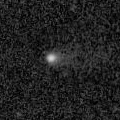
|
Now it is 14.3 mag (Jan. 31, H. Nohara). It stays 15-16 mag and observable in good condition until spring. It is brighter than this ephemeris recently.
Date(TT) R.A. (2000) Decl. Delta r Elong. m1 Best Time(A, h)
Feb. 11 9 28.59 25 49.9 2.397 3.370 168 15.8 0:08 (180, 29)
Feb. 18 9 26.20 26 42.5 2.414 3.371 162 15.8 23:34 (180, 28)
|
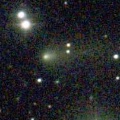
|
Now it is 14.4 mag (Jan. 19, Toshihiko Ikemura, Hirohisa Sato). It will be fading after this, and it will be fainter than 18 mag in spring. It is observable in good condition in the Northern Hemisphere. It locates somewhat low in the Southern Hemisphere. It is brighter than this ephemeris recently.
Date(TT) R.A. (2000) Decl. Delta r Elong. m1 Best Time(A, h)
Feb. 11 7 28.69 25 8.8 1.750 2.641 148 15.8 22:04 (180, 30)
Feb. 18 7 26.53 25 26.1 1.823 2.662 140 16.0 21:34 (180, 30)
|
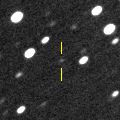
|
Now it is 15.6 mag (Feb. 6, ATLAS Chile). It is expected to brighten up to 12-13 mag from 2024 to 2025.
Date(TT) R.A. (2000) Decl. Delta r Elong. m1 Best Time(A, h)
Feb. 11 9 52.36 -17 33.6 5.286 6.144 147 16.0 0:31 (180, 73)
Feb. 18 9 45.83 -16 43.7 5.217 6.101 151 15.9 23:53 (180, 72)
|
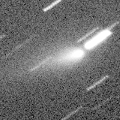
|
Outburst occured in early October, and it brightened up to 9.9 mag (Oct. 14, Thomas Lehmann). It is bright as 13.1 mag still now (Jan. 14, Thomas Lehmann). It stays observable only until February in the Southern Hemisphere, or until March in the Northern Hemisphere.
Date(TT) R.A. (2000) Decl. Delta r Elong. m1 Best Time(A, h)
Feb. 11 0 29.87 -3 48.3 2.858 2.256 44 16.0 20:31 ( 92, 9)
Feb. 18 0 41.81 -2 13.4 2.977 2.314 40 16.3 20:21 ( 93, 7)
|

|
Now it is 15.6 mag (Jan. 29, ATLAS Chile). It was expected to brighten up to 13 mag in 2022 spring. But actually, it was fainter than originally expected. In the Southern Hemisphere, it stays observable in good condition for a long time, although it becomes unobservable temporarily from April to May. In the Northern Hemisphere, it will be unobservable in March.
Date(TT) R.A. (2000) Decl. Delta r Elong. m1 Best Time(A, h)
Feb. 11 2 13.15 -26 55.4 4.174 3.867 65 16.1 20:31 ( 84, 42)
Feb. 18 2 13.67 -24 52.8 4.300 3.905 60 16.3 20:21 ( 84, 38)
|
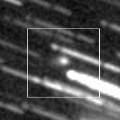
|
Now it is 17.5 mag (Jan. 29, P. Carson). It is expected to brighten up to 11.5 mag in 2024 spring. It stays observable in good condition for a long time. Appearing in the morning sky also in the Southern Hemisphere. At the high light, it will be observable in excellent condition in the Southern Hemisphere, but it will be low in the Northern Hemisphere.
Date(TT) R.A. (2000) Decl. Delta r Elong. m1 Best Time(A, h)
Feb. 11 18 33.27 14 54.8 5.245 4.730 53 16.3 3:56 (251, 0)
Feb. 18 18 35.04 15 13.1 5.122 4.678 58 16.2 4:05 (246, 7)
|
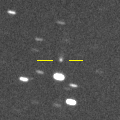
|
It was predicted to brighten up to 16 mag in 2023. But actually, it is not detected, fainter than 18 mag (Jan. 30, Martin Masek). In the Southern Hemisphere, it stays observable in good condition for a long time. In the Northern Hemisphere, it will never be observable again.
Date(TT) R.A. (2000) Decl. Delta r Elong. m1 Best Time(A, h)
Feb. 11 16 40.65 -69 55.8 3.424 3.242 71 16.3 3:56 (338, 46)
Feb. 18 17 6.95 -71 6.1 3.379 3.243 73 16.3 4:05 (340, 46)
|
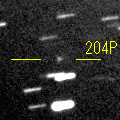
|
It brightened rapidly. Now it is 16.2 mag (Jan. 29, Toshihiko Ikemura, Hirohisa Sato). It is observable at 16 mag in good condition in winter.
Date(TT) R.A. (2000) Decl. Delta r Elong. m1 Best Time(A, h)
Feb. 11 10 9.15 19 38.0 1.003 1.983 170 16.3 0:48 (180, 36)
Feb. 18 10 4.70 20 30.5 1.024 2.006 171 16.4 0:16 (180, 35)
|
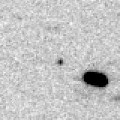
|
Now it is 16.2 mag (Jan. 29, Toshihiko Ikemura, Hirohisa Sato). It stays observable at 16 mag for a long time from early 2023 to early 2024. In the Northern Hemisphere, it is observable only until 2023 spring.
Date(TT) R.A. (2000) Decl. Delta r Elong. m1 Best Time(A, h)
Feb. 11 9 33.50 -4 24.2 3.275 4.222 161 16.3 0:13 (180, 59)
Feb. 18 9 23.67 -5 2.9 3.249 4.193 160 16.3 23:30 (180, 60)
|

|
It was observed at 15 mag from 2021 to 2022. Now it is fading. In the Southern Hemisphere, it stays observable in excellent condition for a long time. In the Northern Hemiphere, it is not observable after this. It has not been observed since late September.
Date(TT) R.A. (2000) Decl. Delta r Elong. m1 Best Time(A, h)
Feb. 11 15 13.76 -66 41.3 6.215 6.106 79 16.3 3:56 (341, 54)
Feb. 18 15 8.58 -67 57.2 6.159 6.135 84 16.3 4:05 (348, 55)
|
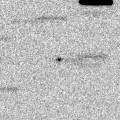
|
Now it is 16.5 mag (Jan. 28, Ken-ichi Kadota). It is observable at 16.5 mag in good condition from January to March. It locates somewhat low in the Southern Hemisphere.
Date(TT) R.A. (2000) Decl. Delta r Elong. m1 Best Time(A, h)
Feb. 11 12 54.41 28 2.5 0.344 1.244 132 16.4 3:32 (180, 27)
Feb. 18 13 11.56 29 23.9 0.353 1.256 133 16.3 3:22 (180, 26)
|
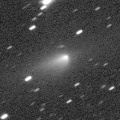
|
It brightened up to 12.7 mag in last year (Feb. 27, 2022, Jose Guilherme de S. Aguiar). Now it is fading. Appearing in the morning sky. In the Southern Hemisphere, it stays observable until summer when it becomes fainter than 18 mag. It locates low in the Northern Hemisphere.
Date(TT) R.A. (2000) Decl. Delta r Elong. m1 Best Time(A, h)
Feb. 11 18 24.92 -25 50.2 3.197 2.611 46 16.4 3:56 (285, 25)
Feb. 18 18 37.13 -25 47.6 3.152 2.635 50 16.5 4:05 (282, 30)
|

|
Now it is 16.2 mag (Jan. 27, Toshihiko Ikemura, Hirohisa Sato). It moves along an almost circular orbit. It seems to be bright temporarily in outburst.
Date(TT) R.A. (2000) Decl. Delta r Elong. m1 Best Time(A, h)
Feb. 11 11 0.54 24 30.6 5.218 6.142 157 16.5 1:39 (180, 31)
Feb. 18 10 57.72 24 54.6 5.194 6.141 161 16.5 1:09 (180, 30)
|
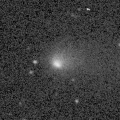
|
It brightened up to 14.6 mag in autumn (Oct. 19, Toshihiko Ikemura, Hirohisa Sato). Now it is fading. It has already faded down to 17.1 mag (Jan. 19, Toshihiko Ikemura, Hirohisa Sato). It will be fainter than 18 mag in spring.
Date(TT) R.A. (2000) Decl. Delta r Elong. m1 Best Time(A, h)
Feb. 11 2 35.23 8 57.0 2.280 2.283 77 16.5 20:31 (123, 26)
Feb. 18 2 46.42 10 0.6 2.377 2.303 73 16.6 20:21 (123, 24)
|
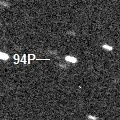
|
Now it is 16.9 mag (Jan. 25, Toshihiko Ikemura, Hirohisa Sato). It is observable at 16.5 mag in good condition in spring. It locates somewhat low in the Southern Hemisphere.
Date(TT) R.A. (2000) Decl. Delta r Elong. m1 Best Time(A, h)
Feb. 11 8 23.05 28 35.0 1.386 2.330 157 16.6 22:58 (180, 26)
Feb. 18 8 18.50 28 50.5 1.406 2.316 150 16.5 22:26 (180, 26)
|
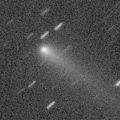
|
It brightened up to 14.1 mag in autumn (Nov. 14, Thomas Lehmann). Now it is fading. It has already faded down to 15.8 mag (Jan. 21, Toshihiko Ikemura, Hirohisa Sato). In the Northern Hemisphere, it stays observable in excellent condition for a while. In the Southern Hemisphere, it will be unobservable soon.
Date(TT) R.A. (2000) Decl. Delta r Elong. m1 Best Time(A, h)
Feb. 11 2 42.46 32 2.4 2.447 2.583 86 16.6 20:31 (140, 9)
Feb. 18 2 52.57 32 46.4 2.551 2.604 82 16.7 20:21 (140, 8)
|
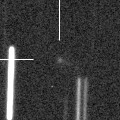
|
Now it is 16.5 mag (Jan. 29, H. Nohara). It will brighten up to 13 mag in summer. In the Northern Hemisphere, it stays observable in good condition for a long time. In the Southern Hemisphere, it is not observable until August.
Date(TT) R.A. (2000) Decl. Delta r Elong. m1 Best Time(A, h)
Feb. 11 7 59.20 78 33.4 1.693 2.288 114 16.7 22:29 (180,-24)
Feb. 18 6 13.43 79 50.9 1.715 2.218 107 16.6 20:21 (180,-25)
|
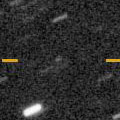
|
Appearing in the morning sky. It stays observable at 14-15 mag from spring to autumn. It locates somewhat low in the Northern Hemisphere.
Date(TT) R.A. (2000) Decl. Delta r Elong. m1 Best Time(A, h)
Feb. 11 17 26.28 -12 37.2 3.535 3.169 60 16.8 3:56 (265, 30)
Feb. 18 17 35.11 -12 58.7 3.432 3.150 65 16.6 4:05 (260, 36)
|
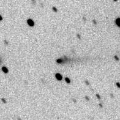
|
Now it is 16.4 mag (Jan. 19, Toshihiko Ikemura, Hirohisa Sato). It is observable at 16-17 mag in excellent condition from autumn to winter.
Date(TT) R.A. (2000) Decl. Delta r Elong. m1 Best Time(A, h)
Feb. 11 4 6.45 1 0.9 3.253 3.522 97 16.7 20:31 (139, 46)
Feb. 18 4 9.97 1 37.3 3.354 3.528 91 16.8 20:21 (135, 43)
|
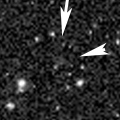
|
Now it is 16.7 mag (Jan. 29, ATLAS South Africa). Very far object. It stays 16-17 mag for a long time from 2021 to 2026. In the Southern Hemisphere, it stays observable in good condition for a long time. In the Northern Hemisphere, it is not observable at all.
Date(TT) R.A. (2000) Decl. Delta r Elong. m1 Best Time(A, h)
Feb. 11 5 26.94 -75 6.6 10.494 10.419 82 16.9 20:31 ( 3, 50)
Feb. 18 5 17.97 -74 32.2 10.482 10.414 83 16.9 20:21 ( 6, 50)
|
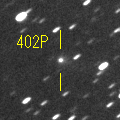
|
It brightened up to 15.3 mag in last winter (Jan. 12, 2022, H. Nohara). Now it is fading. It has already faded down to 17.2 mag (Jan. 28, Toshihiko Ikemura, Hirohisa Sato). It will be observable at 17 mag in good condition in next winter. It locates low in the Southern Hemisphere.
Date(TT) R.A. (2000) Decl. Delta r Elong. m1 Best Time(A, h)
Feb. 11 10 12.49 27 40.7 3.630 4.587 164 17.1 0:52 (180, 27)
Feb. 18 10 8.80 28 29.1 3.651 4.606 163 17.1 0:20 (180, 27)
|
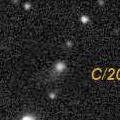
|
Now it is 17.1 mag (Feb. 2, ATLAS South Africa). It stays 17 mag and observable in good condition until summer.
Date(TT) R.A. (2000) Decl. Delta r Elong. m1 Best Time(A, h)
Feb. 11 13 26.63 7 10.9 8.324 8.901 123 17.1 3:56 (183, 48)
Feb. 18 13 23.63 7 45.2 8.232 8.907 130 17.1 3:34 (180, 47)
|

|
Now it is 17.0 mag (Feb. 1, R. Naves, J. Smith, M. Campas). In the Northern Hemisphere, it stays observable at 17 mag in excellent condition from February to March. In the Southern Hemisphere, it is not observable until late March.
Date(TT) R.A. (2000) Decl. Delta r Elong. m1 Best Time(A, h)
Feb. 11 14 11.28 70 20.3 1.302 1.890 110 17.3 3:56 (185,-16)
Feb. 18 12 40.41 73 53.0 1.235 1.870 114 17.2 2:55 (180,-19)
|
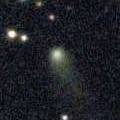
|
Now it is 17.1 mag (Jan. 27, Toshihiko Ikemura, Hirohisa Sato). Fading slowly. In the Southern Hemisphere, it is not observable after this.
Date(TT) R.A. (2000) Decl. Delta r Elong. m1 Best Time(A, h)
Feb. 11 18 11.82 45 42.2 6.250 6.080 75 17.3 3:56 (224,-14)
Feb. 18 18 18.41 46 50.2 6.255 6.113 77 17.3 4:05 (219,-11)
|

|
Now it is 17.2 mag (Feb. 5, C. Fornari). It brightens up to 16.5 mag from March to April. In the Southern Hemisphere, it stays observable in excellent condition. In the Northern Hemisphere, it is not observable until the end of March.
Date(TT) R.A. (2000) Decl. Delta r Elong. m1 Best Time(A, h)
Feb. 11 11 8.83 -56 28.1 1.224 1.779 106 17.4 1:47 ( 0, 68)
Feb. 18 11 17.03 -56 47.6 1.165 1.763 109 17.3 1:28 ( 0, 68)
|

|
It brightened very rapidly up to 15.5 mag from last autumn to last winter (Nov. 2, 2021, Toshihiko Ikemura, Hirohisa Sato). Now it is fading slowly. It has already faded down to 16.7 mag (Jan. 19, ATLAS Chile).
Date(TT) R.A. (2000) Decl. Delta r Elong. m1 Best Time(A, h)
Feb. 11 6 10.89 9 55.8 3.902 4.596 129 17.4 20:46 (180, 45)
Feb. 18 6 10.21 10 7.8 4.006 4.617 122 17.4 20:21 (179, 45)
|
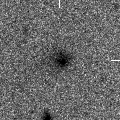
|
Now it is 17.8 mag (Feb. 1, ATLAS Chile). Very large comet. It is expected to brighten up to 14 mag in 2031. In the Southern Hemisphere, it stays observable in good condition for a long time. In the Northern Hemisphere, it is not observable until 2030.
Date(TT) R.A. (2000) Decl. Delta r Elong. m1 Best Time(A, h)
Feb. 11 2 28.84 -59 11.7 18.329 18.001 69 17.4 20:31 ( 38, 49)
Feb. 18 2 29.93 -58 54.9 18.326 17.976 67 17.4 20:21 ( 39, 47)
|

|
Now it is 17.4 mag (Jan. 29, Toshihiko Ikemura, Hirohisa Sato). Fading slowly. In the Northern Hemisphere, it stays observable in good condition for a long time. In the Southern Hemisphere, it is not observable after this.
Date(TT) R.A. (2000) Decl. Delta r Elong. m1 Best Time(A, h)
Feb. 11 18 21.92 67 27.0 9.674 9.706 88 17.4 3:56 (205,-27)
Feb. 18 18 25.48 68 16.8 9.691 9.723 88 17.4 4:05 (202,-25)
|
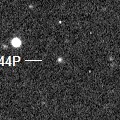
|
Now it is 17.2 mag (Jan. 27, J. L. Virlichie, P. Traverse, H. Roy, G. Houdin). It is observable at 17 mag in good condition in winter. It locates somewhat low in the Southern Hemisphere.
Date(TT) R.A. (2000) Decl. Delta r Elong. m1 Best Time(A, h)
Feb. 11 5 47.63 26 1.8 3.278 3.935 125 17.4 20:31 (178, 29)
Feb. 18 5 47.61 25 56.9 3.369 3.937 118 17.5 20:21 (174, 29)
|

|
It has not been observed yet in this apparition. In the last apparition, it had faded before the perihelion passage. If it becomes as bright as its last apparition, it will brighten up to 17 mag. It stays observable in good condition for a long time.
Date(TT) R.A. (2000) Decl. Delta r Elong. m1 Best Time(A, h)
Feb. 11 14 6.72 0 21.3 2.374 2.888 111 17.6 3:56 (201, 53)
Feb. 18 14 10.57 0 43.6 2.274 2.870 117 17.4 4:05 (187, 54)
|

|
Now it is 17.4 mag (Jan. 18, Toshihiko Ikemura, Hirohisa Sato). It stays 17 mag for a long time from 2023 to 2024. It is observable in good condition in the Northern Hemisphere. It locates low in the Southern Hemisphere.
Date(TT) R.A. (2000) Decl. Delta r Elong. m1 Best Time(A, h)
Feb. 11 2 27.71 28 2.0 7.081 7.015 82 17.6 20:31 (135, 10)
Feb. 18 2 30.62 28 9.2 7.176 7.002 75 17.6 20:21 (133, 8)
|

|
Now it is 19.3 mag (Jan. 24, Toshihiko Ikemura, Hirohisa Sato). It will brighten very rapidly up to 11.5 mag in April. In the Southern Hemisphere, it stays observable in good condition for a long time. In the Northern Hemisphere, it is not observable from mid April to mid June.
Date(TT) R.A. (2000) Decl. Delta r Elong. m1 Best Time(A, h)
Feb. 11 13 5.52 19 39.6 0.727 1.556 129 18.0 3:43 (180, 35)
Feb. 18 13 18.01 20 40.5 0.623 1.483 132 17.6 3:28 (180, 34)
|
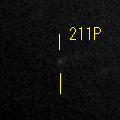
|
Now it is 17.9 mag (Jan. 27, Purple Mountain Observatory, XuYi Station). It brightens up to 17.5 mag from January to February. It locates somewhat low in the Southern Hemisphere.
Date(TT) R.A. (2000) Decl. Delta r Elong. m1 Best Time(A, h)
Feb. 11 12 2.82 22 1.5 1.605 2.475 144 17.7 2:41 (180, 33)
Feb. 18 12 0.87 23 30.6 1.586 2.491 149 17.7 2:12 (180, 32)
|

|
Now it is 17.6 mag (Jan. 22, iTelescope Observatory, Siding Spring). It is observable at 17.5 mag in good condition in winter.
Date(TT) R.A. (2000) Decl. Delta r Elong. m1 Best Time(A, h)
Feb. 11 8 44.43 0 0.8 2.553 3.500 160 17.7 23:19 (180, 55)
Feb. 18 8 41.28 0 20.0 2.574 3.502 156 17.8 22:49 (180, 55)
|
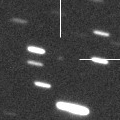
|
Now it is 17.9 mag (Jan. 17, A. Diepvens). It stays 17.5 mag until spring. It is observable in good condition in the Northern Hemisphere. It is not observable in the Southern Hemisphere.
Date(TT) R.A. (2000) Decl. Delta r Elong. m1 Best Time(A, h)
Feb. 11 1 9.35 79 49.3 2.838 3.133 98 17.7 20:31 (169,-31)
Feb. 18 2 6.62 78 49.8 2.861 3.128 96 17.7 20:21 (169,-29)
|
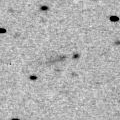
|
Now it is 18.6 mag (Jan. 21, Toshihiko Ikemura, Hirohisa Sato). It stays observable at 18 mag in good condition from January to March.
Date(TT) R.A. (2000) Decl. Delta r Elong. m1 Best Time(A, h)
Feb. 11 10 26.02 13 51.8 3.228 4.198 167 17.8 1:05 (180, 41)
Feb. 18 10 22.76 14 19.6 3.209 4.194 174 17.8 0:34 (180, 41)
|

|
Now it is 17.9 mag (Jan. 26, ATLAS-HKO, Haleakala). In the Northern Hemisphere, it stays observable at 17.5 mag in good condition from spring to summer. In the Southern Hemisphere, it locates extremely low only in summer.
Date(TT) R.A. (2000) Decl. Delta r Elong. m1 Best Time(A, h)
Feb. 11 13 10.70 41 18.5 2.694 3.376 126 17.9 3:49 (180, 14)
Feb. 18 13 13.84 43 26.9 2.636 3.341 128 17.8 3:24 (180, 12)
|
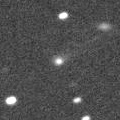
|
It brightened up to 15.9 mag in 2022 spring (May 5, Toshiyuki Takahashi). In 2023, it is observable at 17.5 mag in spring.
Date(TT) R.A. (2000) Decl. Delta r Elong. m1 Best Time(A, h)
Feb. 11 16 16.28 -23 13.8 4.997 4.843 75 17.9 3:56 (265, 50)
Feb. 18 16 20.34 -23 28.9 4.896 4.849 81 17.9 4:05 (260, 56)
|

|
Now it is 18.0 mag (Jan. 24, Toshihiko Ikemura, Hirohisa Sato). It will brighten up to 15 mag from 2024 to 2025. In 2023, it is observable at 18 mag in spring.
Date(TT) R.A. (2000) Decl. Delta r Elong. m1 Best Time(A, h)
Feb. 11 9 54.81 25 4.2 3.433 4.404 168 18.0 0:34 (180, 30)
Feb. 18 9 50.01 25 29.0 3.427 4.392 166 17.9 0:02 (180, 30)
|
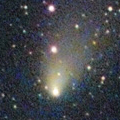
|
It brightened up to 10.4 mag from June to July (July 22, Ken-ichi Kadota). Now it is fading. Appearing in the morning sky in the Souther Hemisphere. It was originally predicted as 15 mag now. But actually, now it is very faint as 18.4 mag (Jan. 2, Martin Masek). It will never be observable again in the Northern Hemisphere.
Date(TT) R.A. (2000) Decl. Delta r Elong. m1 Best Time(A, h)
Feb. 11 20 47.88 -63 33.2 3.529 2.991 49 19.8 3:56 (334, 22)
Feb. 18 21 8.49 -63 4.2 3.576 3.069 52 20.0 4:05 (332, 23)
|
|
![]()
 C/2021 T4 ( Lemmon )
C/2021 T4 ( Lemmon ) C/2021 X1 ( Maury-Attard )
C/2021 X1 ( Maury-Attard ) 77P/Longmore
77P/Longmore C/2021 S3 ( PanSTARRS )
C/2021 S3 ( PanSTARRS ) C/2021 E3 ( ZTF )
C/2021 E3 ( ZTF ) C/2021 G2 ( ATLAS )
C/2021 G2 ( ATLAS ) C/2020 R7 ( ATLAS )
C/2020 R7 ( ATLAS ) 117P/Helin-Roman-Alu 1
117P/Helin-Roman-Alu 1 C/2020 S4 ( PanSTARRS )
C/2020 S4 ( PanSTARRS ) 119P/Parker-Hartley
119P/Parker-Hartley C/2022 E2 ( ATLAS )
C/2022 E2 ( ATLAS ) 73P/Schwassmann-Wachmann 3
73P/Schwassmann-Wachmann 3 C/2020 Y2 ( ATLAS )
C/2020 Y2 ( ATLAS ) C/2022 L2 ( ATLAS )
C/2022 L2 ( ATLAS ) C/2021 C5 ( PanSTARRS )
C/2021 C5 ( PanSTARRS ) 204P/LINEAR-NEAT
204P/LINEAR-NEAT C/2022 A3 ( Lemmon-ATLAS )
C/2022 A3 ( Lemmon-ATLAS ) C/2018 U1 ( Lemmon )
C/2018 U1 ( Lemmon ) 263P/Gibbs
263P/Gibbs 116P/Wild 4
116P/Wild 4 P/2023 B1 ( PanSTARRS )
P/2023 B1 ( PanSTARRS ) 61P/Shajn-Schaldach
61P/Shajn-Schaldach 94P/Russell 4
94P/Russell 4 P/2022 L3 ( ATLAS )
P/2022 L3 ( ATLAS ) C/2022 W3 ( Leonard )
C/2022 W3 ( Leonard ) 199P/Shoemaker 4
199P/Shoemaker 4 408P/2020 M7 ( Novichonok-Gerke )
408P/2020 M7 ( Novichonok-Gerke ) C/2019 E3 ( ATLAS )
C/2019 E3 ( ATLAS ) 402P/2020 Q3 ( LINEAR )
402P/2020 Q3 ( LINEAR ) C/2020 F2 ( ATLAS )
C/2020 F2 ( ATLAS ) C/2023 A1 ( Leonard )
C/2023 A1 ( Leonard ) C/2020 H6 ( ATLAS )
C/2020 H6 ( ATLAS ) C/2023 B2 ( ATLAS )
C/2023 B2 ( ATLAS ) P/2021 N2 ( Fuls )
P/2021 N2 ( Fuls ) C/2014 UN271 ( Bernardinelli-Bernstein )
C/2014 UN271 ( Bernardinelli-Bernstein ) C/2019 O3 ( Palomar )
C/2019 O3 ( Palomar ) 244P/Scotti
244P/Scotti 280P/Larsen
280P/Larsen C/2021 S4 ( Tsuchinshan )
C/2021 S4 ( Tsuchinshan ) 364P/PanSTARRS
364P/PanSTARRS 211P/Hill
211P/Hill P/2021 V2 ( Fuls )
P/2021 V2 ( Fuls ) C/2022 W2 ( ATLAS )
C/2022 W2 ( ATLAS ) 452P/2022 B5 ( Sheppard-Jewitt )
452P/2022 B5 ( Sheppard-Jewitt ) C/2022 U4 ( Bok )
C/2022 U4 ( Bok ) 99P/Kowal 1
99P/Kowal 1 65P/Gunn
65P/Gunn C/2021 P4 ( ATLAS )
C/2021 P4 ( ATLAS )![]()
























































